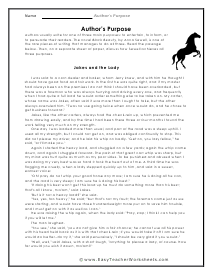There are three main reasons why an author writes something: to entertain, inform, or persuade (or sometimes all three at once!). When we are trying to grasp why an author sat down to write the piece that you are reading, there are several ways to tell tale signs that you can use to determine this. If the story presents a number of different facts or attempts to explain something it was most likely composed to inform the reader. This is common of news articles and textbooks. If the work diverts readers into a new realm towards the goal of amusing us, then it was written to entertain. This is common of stories and funny poems. If the work tries to get you to take some kind of whether it is to agree with the writer or reaffirm what you already believe the goal of the work is to persuade. You see this in advertisements and editorial pieces.
This collection of worksheets presents short passages, advertisements, excerpts, recipes, and other samples, and the students must determine the reason behind the writing. Students will learn how to use context and language clues in order to determine the purpose of the passage. Answer keys have been provided for each worksheet. Project idea: Have your students pick a topic and write three passages about it: one to entertain, one to inform, and one to persuade.





























